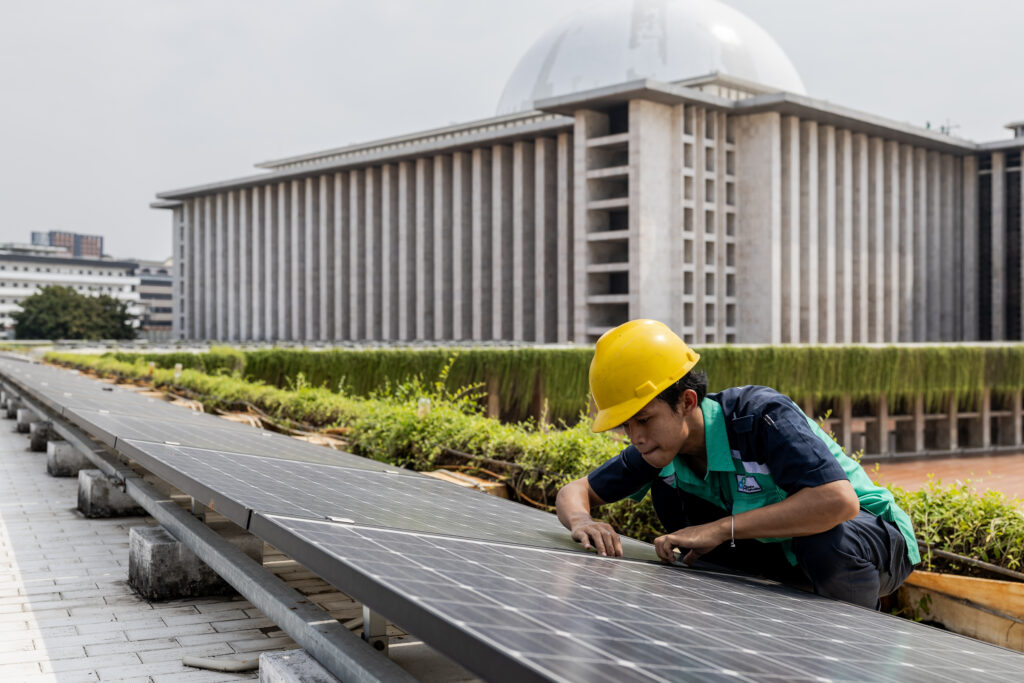In 2023, around 84 per cent of new global electricity capacity was solar and wind power, with all other technologies — coal, gas, nuclear, hydropower and other renewables — constituting the remaining 16 per cent. As solar and wind prices continue to drop, the fastest energy change in history is well underway.
Approximately three quarters of the global population live in the sunbelt region — between 35 degrees of northern and southern latitude — which has excellent solar resources all year round. This region is also experiencing the fastest growth in population, energy consumption and emissions.
Rising living standards combined with the electrification of industry, transport, heating and cooling will likely cause a tenfold increase in electricity demand in Southeast Asia. For countries that have developed large chemical industries focused on green hydrogen products, electricity demand could double again. This is consistent with electricity demand estimates in Australia. Southeast Asia is at the beginning of a rapid energy change.
Policymakers have raised the potential of nuclear power, bioenergy, hydroelectricity, geothermal energy, and carbon capture and storage in decarbonising Southeast Asia’s energy system. But these technologies have either failed to compete at scale in the global energy marketplace or are highly constrained in their ability to be rapidly deployed. In comparison, solar and wind are dominating construction markets. The deployment rate of solar is doubling every three years and is now 20 times faster than the combined global annual deployment of all other low-emission technologies, excluding wind.
Solar photovoltaic (PV) technology is the cheapest form of new electricity and is essentially unconstrained in its ability to be deployed throughout the sunbelt. Australia is a global leader in using solar and wind to decarbonise its energy system and is tracking towards 82 per cent renewable electricity in 2030, convincingly demonstrating that renewable energy leads to low energy prices and emissions.
But solar anxiety in Southeast Asia remains high. Vietnam’s highly successful rooftop solar program has resulted in high levels of grid congestion, as installation outpaced transmission upgrades and the deployment of energy storage technologies.
There are misguided concerns about the cost of solar PV and the impact of large amounts of solar on grid reliability. Some analyses erroneously suggest that the amount of solar that can be physically built is small. With proper planning, it is possible for solar generation alone to meet all electricity demand in the sunbelt. If other low emission technologies become cost-competitive, then so much the better.
Malaysia can be looked to as a case study for countries in the sunbelt region. Energy balance modelling indicates that about 660 gigawatts of solar could decarbonise the energy system of an affluent, fully electrified Malaysia. This would represent the end of a 26-year pathway through which solar manufacturing, supply chains and installer markets all have the opportunity to mature within Malaysia. Australia is on a similar pathway and already has a generation mix that is 40 per cent renewables. The exponential growth of solar has been accompanied by decreasing capital costs.
There is the potential to install roughly 8500 gigawatts of solar PV on rooftops, facades and non-forested ground; floating on lakes and reservoirs; and integrated with agriculture. There is also an enormous opportunity for offshore floating solar on calm equatorial oceans. Malaysia could deploy roughly 25,000 gigawatts of maritime floating PV in regions that never experience large waves or strong winds. Policymakers should be very wary of anyone suggesting that the potential for solar PV is limited.
It is essential for overnight energy storage to be built alongside widespread solar deployment. Luckily, most sunbelt countries have access to nearly unlimited off-river pumped hydro energy storage. Malaysia has about 450,000 gigawatt-hours of off-river pumped hydro potential, which is 100–200 times more than the amount required to support decarbonisation of the country’s entire energy system.
Off-river pumped hydro is a mature technology that has a small environmental footprint, low water usage and offers the cheapest long-duration energy storage. Southeast Asia has a workforce skilled in developing conventional hydroelectric power stations which can be readily transferred to developing pumped hydro systems.
The all-in cost for an affluent, fully electrified Malaysia to decarbonise its energy system using solar and off-river pumped hydro is roughly US$95–103 per megawatt hour. With electricity tariffs in peninsular Malaysia currently up to US$120 per megawatt hour, there is no need to wait for large cost reductions in other low emission technologies.
To push Southeast Asia over into its solar-dominant future, it’s important to establish that solar and pumped hydro potential are effectively unconstrained from a technical standpoint. Solar-dominant grids are reliable and low-cost ventures when distributed across a large transmission backbone supported by long-duration energy storage.
Once the solar anxiety has passed, removing barriers that prevent rooftop solar or independent power producers from connecting to the grid is essential in driving price discovery and establishing a large solar industry. As supply chains and the solar installer workforce develop, solar and associated capital costs will drop further.
Market reforms are necessary to ensure that energy storage systems are appropriately rewarded for providing frequency and voltage control, black start capabilities, as well as power and energy reserves. Once the barriers are removed, countries in the sunbelt have an unlimited opportunity for cheap, clean and reliable solar energy.
Timothy Weber is Research Officer at the 100% Renewable Energy Team, The Australian National University.
Andrew Blakers is Professor of Engineering at The Australian National University.

